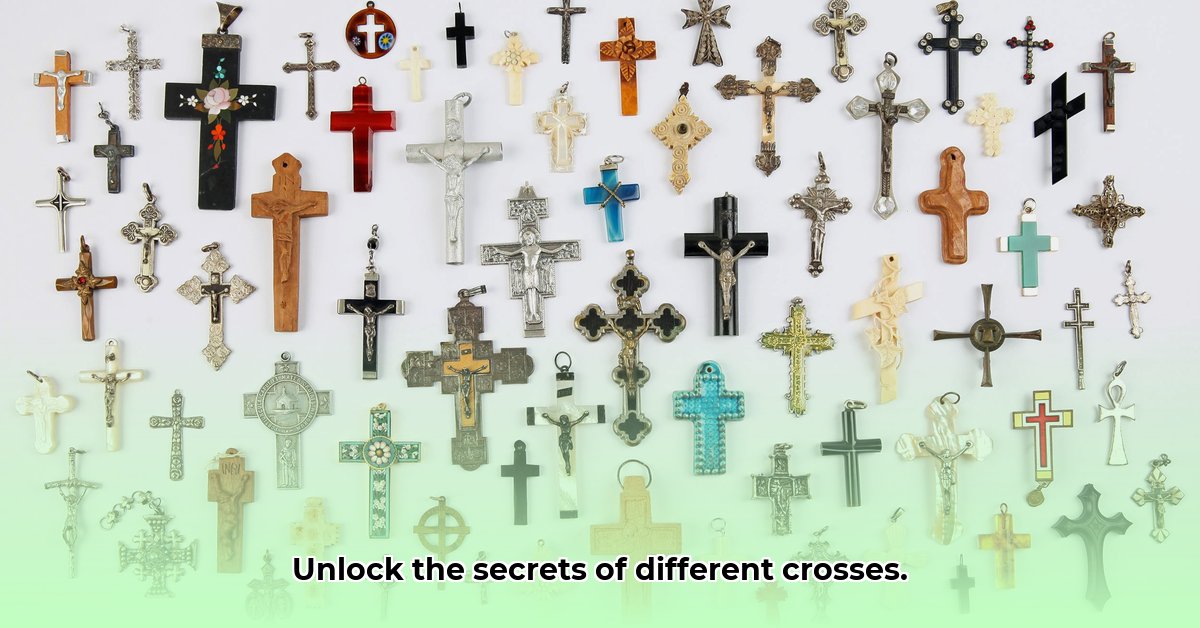Ever noticed how many different kinds of crosses there are? From the simple cross we see everywhere to the really fancy, detailed ones, they all have a story to tell. This isn’t just about pretty pictures; each shape and design has a history, full of meaning and sometimes even mystery. Let’s explore the world of crosses, looking at different styles, what they represent, and how their meanings have changed over time. For more on Catholic crosses, see this helpful guide.
Different Kinds of Crosses: A Comprehensive Overview
The cross: a simple shape, yet incredibly powerful. It’s a symbol packed with meaning, used in religion, culture, and even everyday life. But did you know there are tons of different types of crosses? Let’s dive into their fascinating stories and what they mean. What are the key differences between the Latin cross and the Greek cross?
The Latin Cross: The Foundational Cross
Most people instantly recognize the Latin cross (✝️). It’s got a long vertical line and a shorter horizontal one—pretty straightforward. This design became hugely popular early on in Christianity and is still the most common type you’ll see today. It directly represents the crucifixion of Jesus, making it a powerful symbol of faith, sacrifice, and redemption. Its enduring presence in churches, cemeteries, and personal adornments speaks to its central role in Christian identity.
Beyond the Basics: Exploring Cross Variations
Numerous other cross designs have emerged, each carrying its own unique symbolism and historical significance. These variations often reflect specific theological interpretations, cultural influences, or historical events.
The Greek Cross: Equality and Universality
The Greek cross (✚), also known as the crux immissa quadrata, features arms of equal length. Some believe this symbolizes the four corners of the earth, representing the universal reach of Christianity. This cross is commonly associated with Eastern Orthodox traditions and early Byzantine art, reflecting its historical importance in those contexts.
The St. Andrew’s Cross: Humility and Martyrdom
The St. Andrew’s Cross, or Saltire, is an X-shaped cross. Tradition holds that St. Andrew, the apostle, was martyred on a cross of this shape because he deemed himself unworthy to be crucified on the same type of cross as Jesus. This cross appears on the flag of Scotland and symbolizes humility and sacrifice.
The Maltese Cross: Chivalry and Service
The Maltese Cross features four V-shaped arms that meet at the center, creating eight points. It is associated with the Knights Hospitaller (Knights of Malta), a medieval Christian military order. The eight points are said to represent the eight Beatitudes or the eight obligations of a knight. Today, the Maltese Cross is often used as a symbol of protection and service, particularly by firefighters and other emergency services.
The Tau Cross: Symbol of Salvation and Franciscan Order
The Tau Cross, resembling the Greek letter tau (Τ), is also known as St. Anthony’s Cross. It predates Christianity and was adopted by Christians in the early centuries. St. Francis of Assisi embraced the Tau Cross as his personal emblem, imbuing it with the values of humility, repentance, and salvation.
Celtic Crosses: A Harmonious Blend of Beliefs
The Celtic cross is instantly recognizable with its intricate design and a circle intersecting the cross. These crosses combine Christian symbols with older Celtic designs, representing a fusion of pre-Christian Celtic beliefs and the emerging Christian faith. The circle is open to different interpretations. Some suggest it represents the sun, symbolizing eternity or the all-encompassing nature of God, whilst others view it as a representation of wholeness. The Celtic crosses embody how faith adapts and blends with existing cultures, creating a unique expression of religious identity. How does the Celtic cross symbolize the fusion of cultures?
Coptic Cross: A Symbol of Egyptian Christianity
The Coptic Cross is a distinct symbol of the Coptic Orthodox Church of Alexandria. It often features elaborate designs with flared arms, sometimes adorned with trefoils or other decorative elements. This cross represents the rich heritage of Christianity in Egypt, tracing back to the early centuries of the faith.
The Ankh: An Ancient Symbol of Life
The Ankh (☥) is an ancient Egyptian symbol that sometimes gets included in discussions of crosses due to its similar shape. It’s older than Christianity, and its resemblance to the cross has led some to connect it with Christian ideas, although its origins and primary meaning are distinctly Egyptian. Scholars link it to everlasting life, regeneration, and the life-giving power of the sun. Connecting the Ankh with Christianity requires understanding and respect for its original Egyptian significance. This highlights how interpreting symbols can be complex and requires careful consideration of historical and cultural contexts.
The Jerusalem Cross: A Crusader’s Emblem
The Jerusalem Cross, also known as the Crusader’s Cross, is a distinctive emblem featuring a large central cross surrounded by four smaller crosses. This cross is closely tied to the Crusades, a significant period in Christian history, representing the five wounds of Christ or the spread of Christianity to the four corners of the world from Jerusalem. It is a visually striking symbol of religious zeal and the historical connection to the Holy Land. What historical events shaped the symbolism of the Jerusalem Cross?
The Russian Orthodox Cross: A Detailed Depiction
The Russian Orthodox Cross is a variation of the Christian cross with three horizontal bars. The top bar represents the inscription placed above Jesus’ head, the middle bar represents the main crossbeam, and the slanted bottom bar represents the footrest. The slant of the footrest symbolizes the two thieves crucified alongside Jesus, with one ascending to heaven and the other descending to hell.
A Quick Look at Different Cross Types
Here’s a handy table summarizing some of the main cross types we’ve discussed:
| Cross Type | Description | Possible Symbolism | Historical Context |
|---|---|---|---|
| Latin Cross | Long vertical, short horizontal beam | Jesus’ crucifixion, basic Christian faith, sacrifice, redemption | Early Christianity |
| Greek Cross | Equal-length arms | Four corners of the earth, universality of Christianity | Early Christianity, common in Orthodox Christianity |
| St. Andrew’s Cross | X-shaped diagonal cross | Humility, martyrdom | Tradition of St. Andrew’s crucifixion |
| Maltese Cross | Four V-shaped arms meeting at the center | Chivalry, service, protection, eight Beatitudes | Knights Hospitaller (Knights of Malta), emergency services |
| Tau Cross | Resembles the Greek letter Tau (Τ) | Humility, repentance, salvation | St. Francis of Assisi, early Christian symbolism |
| Celtic Cross | Latin cross with a circle | Eternity, sun, blend of Christian and Celtic beliefs, wholeness | Celtic Christianity, Ireland, Scotland |
| Coptic Cross | Elaborate designs with flared arms | Rich heritage of Christianity in Egypt | Coptic Orthodox Church of Alexandria |
| Ankh | Loop-topped ancient Egyptian symbol | Eternal life, regeneration, life-giving power (primarily Egyptian, debated application in Christianity) | Ancient Egypt, debated interpretations in Christianity |
| Jerusalem Cross | Large cross with four smaller crosses inside | The Crusades, possibly representing the five wounds of Christ, spread of Christianity from Jerusalem | Medieval Period, linked to the Holy Land |
| Russian Orthodox Cross | Three horizontal bars, slanted footrest | Specific Orthodox Christian beliefs about the crucifixion story, the two thieves crucified alongside Jesus | Russian Orthodox Church |
Modern Meanings: Crosses in Contemporary Society
Even today, crosses hold deep meaning for many people. You see them everywhere—on necklaces, in church architecture, as symbols of national heritage, and even on ambulances (the Maltese Cross). This widespread presence demonstrates the cross’s importance beyond its religious origins. It’s clearly a symbol that has shaped our cultures in a number of ways, transcending religion and entering the realms of art, fashion, and civic identity. Crosses remain powerful symbols.
The Ongoing Puzzle: Unanswered Questions and Evolving Interpretations
Studying different types of crosses is fascinating, but it’s also complex. Scholars are always debating different interpretations and origins. It’s important to remember that what we “know” about these symbols can evolve as new evidence emerges. We’re still learning more! Engaging critically with available evidence and acknowledging uncertainties is a vital step in understanding these powerful symbols. The diversity of interpretations is part of what makes this area of study so interesting. How are scholars continuing to reinterpret the symbolism of crosses?
By understanding the history and symbolism of different crosses, we gain a deeper insight into history, art, religion, and the ways different cultures interact and transform symbols over time. It’s a journey through centuries of faith and its diverse expressions.
How to differentiate between Celtic and Ankh cross symbolism
Key Takeaways:
- The cross, a potent symbol, predates Christianity, holding diverse meanings across cultures.
- Variations in cross designs reflect regional influences and religious interpretations.
- Understanding a cross’s historical context is crucial for accurate interpretation.
- How to differentiate between Celtic and Ankh cross symbolism requires examining their distinct shapes, origins, and associated beliefs.
The Cross: A Journey Through Time and Culture
The cross, far from










